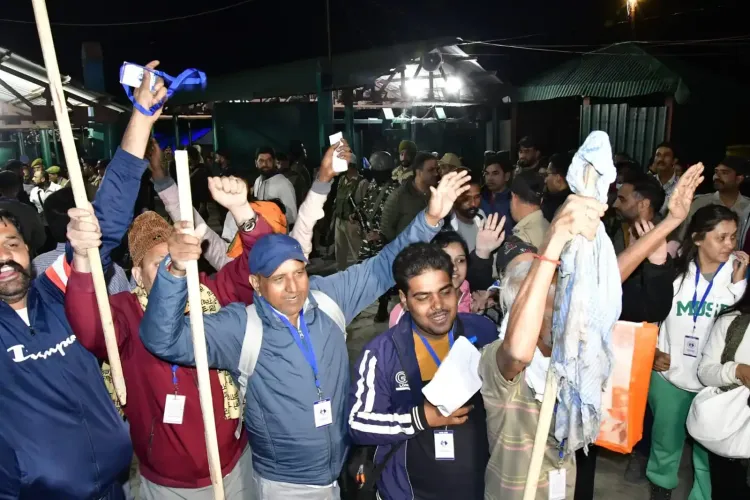How are Pilgrims Expressing Gratitude to the Army and Administration for the Smooth Amarnath Yatra?

Synopsis
Key Takeaways
- Significant turnout of pilgrims this year, showcasing the enduring spirit of faith.
- Enhanced safety and arrangements provided by the administration and Indian Army.
- Pilgrims are advised to travel only in escorted convoys.
- The Yatra concludes on August 9, coinciding with Shravan Purnima.
- The shrine represents a powerful symbol of Lord Shiva.
Jammu, June 3 (NationPress) As the 36-day-long Amarnath Yatra began, a multitude of pilgrims from various parts of the nation gathered in Jammu and Kashmir to embark on this sacred journey and pay their respects at the esteemed Amarnath cave shrine.
Devotees conveyed their profound appreciation for the arrangements put in place by the administration and commended the Indian Army for safeguarding their well-being throughout the pilgrimage.
The inaugural group of Yatris set off from the Baltal base camp early Thursday morning, with another contingent departing from Pahalgam.
Additionally, a second batch of 5,246 pilgrims departed from Bhagwati Nagar Yatri Niwas on Canal Road in Jammu towards the Valley in two secured convoys, highlighting the stringent security protocols established.
In conversations with IANS, pilgrims shared their heartfelt gratitude and delight regarding the efficient arrangements.
One devotee remarked, "I have been visiting Baba Barfani's shrine continuously since 2019, and it feels wonderful every time. The arrangements made by the administration are exceptional."
Another stated, "The government’s preparations are commendable. We are truly pleased."
This year’s turnout appears significantly greater than in previous years. A pilgrim expressed, "In times of unrest, when terror attacks occurred, very few attended the Yatra. However, this year, the numbers are substantial."
Others echoed similar thoughts, observing that while the journey is inherently spiritual and not focused on comfort, the overall experience this year has been markedly smoother.
"When embarking on a pilgrimage, comfort is not the priority. However, this year, the arrangements are remarkable and unparalleled compared to previous years," another devotee shared.
Expressing appreciation for the security forces, another Yatri stated, "The Indian Army has facilitated our travel. They are here for our protection. Furthermore, the arrangements made by both the Centre and the J&K government are truly commendable."
Another added, "The Indian Army and the administration have ensured that all pilgrims can safely continue this holy Yatra without any worries. I am grateful for all that has been done."
The Yatra was officially inaugurated by Jammu and Kashmir Lieutenant Governor Manoj Sinha on Wednesday from Jammu.
Authorities have established an unprecedented security plan following the tragic April 22 terror incident in Pahalgam, which resulted in the deaths of 26 civilians by terrorists linked to Pakistan-backed Lashkar-e-Taiba.
To ensure security, an additional 180 companies of Central Armed Police Forces (CAPFs) have been deployed, augmenting the already comprehensive security framework that includes the Indian Army, paramilitary forces, and J&K Police.
Pilgrims are strongly advised to travel from Jammu to the Valley only as part of escorted convoys and have been cautioned against attempting the journey independently.
The Yatra, which will conclude on August 9, coincides with Shravan Purnima and Raksha Bandhan, allows pilgrims to approach the sacred cave shrine situated at an altitude of 3,888 meters via the traditional Pahalgam route or the shorter Baltal route.
The Pahalgam trek covers 46 km and takes about four days, passing through Chandanwati, Sheshnag, and Panchtarni. The Baltal route, a 14 km trek, enables pilgrims to return to the base camp on the same day.
This year, in response to increased security measures, helicopter services for pilgrims have been suspended.
The shrine contains a naturally occurring ice stalagmite, believed to symbolize Lord Shiva, which waxes and wanes in accordance with the lunar phases. Devotees regard the shrine as a potent emblem of Shiva's divine presence.





